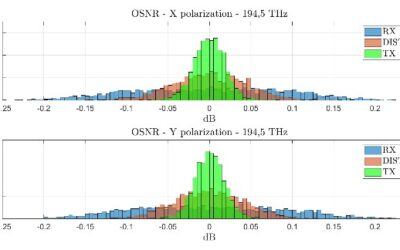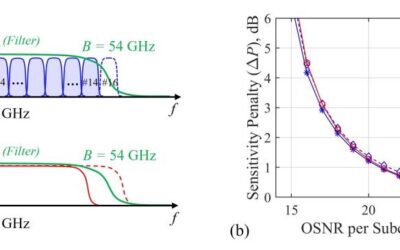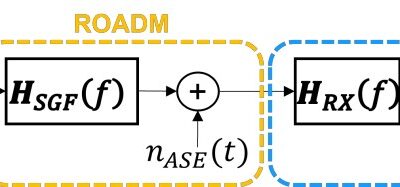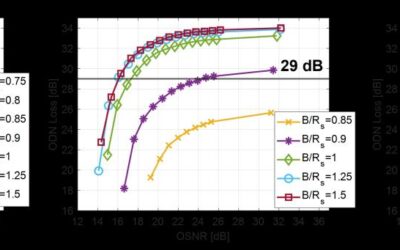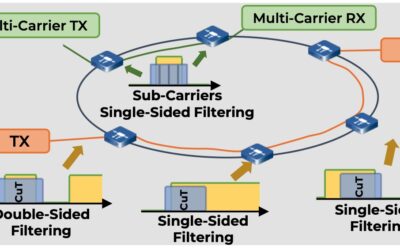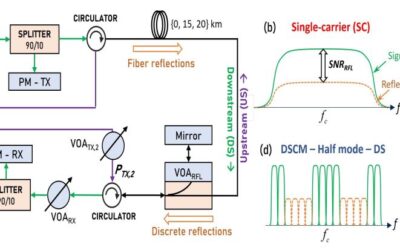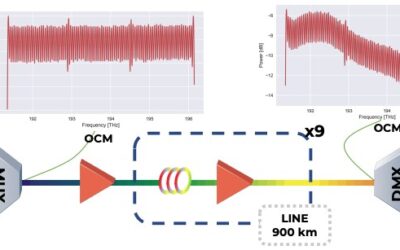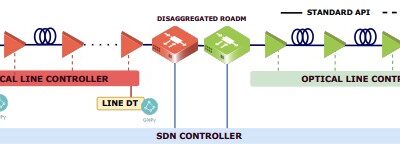About ALLEGRO ‘Agile ultra low energy secure networks’
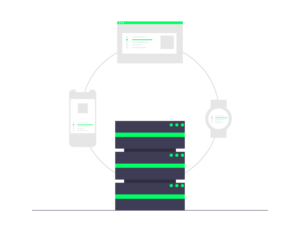 ALLEGRO aims at designing and validating a novel end-to-end sliceable, reliable, and secure architecture for next-generation optical networks, achieving high transmission/switching capacity
ALLEGRO aims at designing and validating a novel end-to-end sliceable, reliable, and secure architecture for next-generation optical networks, achieving high transmission/switching capacity
- with 10 Tb/s for optoelectronic devices and 1 Pbt/s for optical fiber systems
- low power consumption/cost
- with > 25% savings
- and secure infrastructures and data transfers.
The architecture relies on key enabling innovations:
- smart, coherent transceivers exploiting multi-band & multi-fiber technologies for P2P and P2MP applications, based on e.g., high-speed plasmonic modulators/photodetectors and programmable silicon photonic integrated waveguide meshes;
- loss-less, energy-efficient transparent photonic integrated optical switches, eliminating OEO conversions, e.g., with on-chip amplification in the O-band for datacom applications;
- a consistent approach to security, in terms of functional/ protocol architectures and communications, further improving QKD systems, enabling optical channel co-existence and researching on quantum-resistant (post-quantum) cryptography, developing systems based on physically unclonable functions; and
- a scalable AI/ML assisted control and orchestration system, responsible for autonomous networking, dynamic and constrained service provisioning, function placement and resource allocation, leveraging devices increasing programmability and overall network softwarization.
To achieve the target objectives and KPIs, ALLEGRO has defined a clear methodology ending in ambitious demonstrators. The consortium includes a good balance of industry and research/academia with know-how in complementary fields.
The results of ALLEGRO will be disseminated in leading conferences, events, and high-impact journals. They will have a concrete and measurable economic and social impact, contributing towards achieving key European objectives, reinforcing European leadership and digital sovereignty in the ongoing digital and green transition.
Project News
Polarization Dependent Loss in Metropolitan Optical Networks
With the ever-growing demand for Internet traffic, driven by 5G, cloud services, and online applications, metropolitan optical networks are evolving to meet these increasing capacity needs. However, as networks rely more on coherent optical technologies and...
System-Level Model Application in ALLEGRO
As part of our ongoing work in the ALLEGRO project we've been leveraging system-level modeling to analyze and compare the performance of Single Carrier (SC) and Discrete Spectrum Carrier Multiplexing (DSCM) systems under narrow filtering constraints. 🔎 Key Insights:✅...
Experimental Characterization of ODN Loss in (Metro + PON) Systems
In next-generation optical networks, optimizing the Optical Distribution Network (ODN) loss is crucial to balancing power budgets while mitigating nonlinear effects. Our latest experimental study at Allegro evaluates the impact of ASE noise, receiver noise, and filter...
Single Carrier Filtering Model for Metro-Access Scenarios
Coherent detection has revolutionized optical communications since its introduction in long-haul, high-speed systems. Now, as demand for higher data rates grows in access networks and data center interconnects, the industry is exploring how coherent technology could...
Single- and Double-Sided Filtering Modelling in Metro-Core Networks
With the rise of 400G+ coherent technology and its adoption in open pluggable interfaces, computing path feasibility over transparent lightpaths (LPs) has become more crucial than ever—even in metro-core networks. 🔍 Key challenge? While LP performance is typically...
Bidirectional Transmission Modelling in Real-Time
Excited to share our latest work on Bi-Di transmission between two 400G-capable coherent transceivers (TRXs) over a single fibre at 193.0 THz! This setup enables both upstream (US) and downstream (DS) channels to share the same center frequency, pushing the boundaries...
Digital Twin Implementation with Commercial Equipment in Optical Networks
The key to realizing Digital Twins (DTs) in optical networks lies in accurately modeling critical network components—particularly transceivers and optical amplifiers. These components significantly impact the reliability and predictive capabilities of DT frameworks. 📌...
DT-assisted Self-Healing in Partially Disaggregated Networks
We're excited to share our latest work in the ALLEGRO project on Digital Twin (DT) assisted Self-Healing! 🌐✨ By leveraging the open-source GNPy library (by TIP) as a digital model service, we've implemented a DT-driven Optical Line Controller (OLC) capable of...
Hammerstein-Wiener System-Based Nonlinear Model for Chirp Compensation
Excited to share my latest work on chirp compensation using a nonlinear model (NLM) to mitigate the effects of directly modulated VCSELs (DMVCSELs)! By leveraging a Hammerstein-Wiener (HW) system, our trained model utilizes a phase modulator (PM) to correct phase...
BVT Modelling with VCSEL Chirp Dynamics
DM VCSELs (Directly Modulated Vertical-Cavity Surface-Emitting Lasers) are at the core of high-speed optical communication systems, offering compact size and high performance. To enhance the efficiency of Bandwidth-Variable Transmitters (BVTs), we developed a model...
